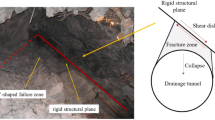Abstract
Doppler laser interferometry is used to measure the transient time between the slow quasi-stationary stage of damage accumulation in rock samples to the ultrafast catastrophic stage of failure as well as the duration of the autocatalytic stage of macroscopic fracture. Small rock samples are tested for compression and three-point bending, and the velocity of displacement of their lateral surfaces is measured up to macroscopic fracture. The surface velocity at the catastrophic stage proves to be three orders of magnitude higher than the average surface velocity at the quasi-stationary stage of damage accumulation. The transient time to catastrophic failure is estimated at 60–100 ms, and the duration of the ultrafast catastrophic failure stage is 15–20 ms for small marble samples. The transient stage is the process of self-organization of individual acts of fracture into the state of self-organized criticality. At this stage, the distribution of individual acts of fracture evolves into power-law distributions. A simple fracture model with power laws is proposed, which is in full agreement with the experimental data. The developed mathematical model is used to calculate fracture of small rock samples, reproducing uniaxial compression and three-point bending tests, as well as fracture in rock masses with mine openings. We also model the process of faulting and fracturing in the mountains of Central Altai, including the foreshock process, main event (the Chuya earthquake of September 27, 2003) and aftershock process. The calculated seismic process fully corresponds to the Gutenberg–Richter recurrence law, and the calculated aftershock process conforms to the Omori law.












Similar content being viewed by others
REFERENCES
Makarov, P.V., Mathematical Theory of Evolution of Loaded Solids and Media, Phys. Mesomech., 2008, vol. 11, no. 5–6, pp. 213–227.
Malinetskii, G.G. and Potapov, A.B., Modern Problems of Nonlinear Dynamics, Moscow: Editorial URSS, 2002.
Makarov, P.V., Evolutionary Nature of Structure Formation in Lithospheric Material: Universal Principle for Fractality of Solids, Russ. Geol. Geophys., 2007, vol. 48, no. 7, pp. 558–574. https://doi.org/10.1016/j.rgg.2007.06.003
Kocharyan, G.G., Kishkina, S.B., and Ostapchuk, A.A., Seismogenic Width of a Fault Zone, Dokl. Earth Sci., 2011, vol. 437, no. 2, pp. 412–415.
Makarov, P.V., Evolutionary Nature of Destruction of Solids and Media, Phys. Mesomech., 2007, vol. 10, no. 3–4, pp. 134–147.
Makarov, P.V., Self-Organized Criticality of Deformation and Prospects for Fracture Prediction, Phys. Mesomech., 2010, vol. 13, no. 5–6, pp. 292–305.
Makarov, P.V., Resonance Structure and Inelastic Strain and Defect Localization in Loaded Media, Phys. Mesomech., 2011, vol. 14, no. 5–6, pp. 297–307.
Makarov, P.V. and Eremin, M.O., Rock Mass as a Nonlinear Dynamical System. Mathematical Modeling of Stress-Strain State Evolution in the Rock Mass around a Mine Opening, Phys. Mesomech., 2018, vol. 21, no. 4, pp. 283–296.
Kerner, B.S. and Osipov, V.V., Autosolitons, Sov. Phys. Usp., 1989, vol. 32, no. 2, pp. 101–138. https://doi.org/10.1070/PU1989v032n02ABEH002679
Makarov, P.V., Eremin, M.O., and Kostandov, Yu.A., Prefracture Time of Gabbro Specimens in a Damage Accumulation Model, Phys. Mesomech., 2014, vol. 17, no. 3, pp. 199–203.
Makarov, P.V. and Eremin, M.O., Fracture Model of Brittle and Quasibrittle Materials and Geomedia, Phys. Mesomech., 2013, vol. 16, no. 3, pp. 207–226.
Smolin, I.Yu., Makarov, P.V., Kulkov, A.S., Eremin, M.O., and Bakeev, R.A., Blow-up Modes in Fracture of Rock Samples and Earth’s Crust Elements, Phys. Mesomech., 2018, vol. 21, no. 4, pp. 297–304.
Bak, P., Tang, C., and Wiesenfeld, K., Self-Organized Criticality: An Explanation of 1/f Noise, Phys. Rev. Lett., 1987, vol. 59, pp. 381–384.
Kurdyumov, S.P., Blow-Up Modes: Evolution of the Idea, Malinetskii, G.G. (Ed.), Moscow: Fizmatlit, 2006.
Akhromeeva, T.S., Kurdyumov, S.P., Malinetskii, G.G., and Samarskii, A.A., Structures and Chaos in Nonlinear Media, Moscow: Fizmatlit, 2007.
Bak, P. and Paczuski, M., Complexity, Contingency and Criticality, Proc. Nat. Acad. Sci. USA, 1995, vol. 92, pp. 6689–6696.
EM–DAT: The OFDA/CRED Info Disaster Database. Universite Catholique de Louvain, Brussels, Belgium.
Kapitza, S.P., On the Theory of Global Population Growth, Phys.-Uspekhi, 2010, vol. 53, no. 12, pp. 1287– 1296.
Garagash, I.A. and Nikolaevskii, V.N., Nonassociated Flow Rule and Plastic Strain Localization, Usp. Mekh., 1989, vol. 12, no. 1, pp. 131–183.
Makarov, P.V. and Peryshkin, A.Yu., Slow Motions as Inelastic Strain Autowaves in Ductile and Brittle Media, Phys. Mesomech., 2017, vol. 20, no. 2, pp. 209–221.
Novikov, I.S., Emanov, E.A., Leskova, V.A., Batalev, V.Yu., Rybin, A.K., and Bataleva, E.A., The System of Neotectonic Faults in Southeastern Altai: Orientations and Geometry of Motion, Russ. Geol. Geophys., 2008, vol. 49, no. 11, pp. 859–867.
Rogozhin, E.A., Ovsyuchenko, A.N., Marakhanov, A.V., and Ushanova, E.A., Tectonic Setting and Geological Manifestations of the 2003 Altai Earthquake, Geotectonics, 2007, vol. 41, pp. 87–104.
Eremin, M.O., Makarov, P.V., and Peryshkin, A.Yu., Modeling of the Recent Evolution of the Folded Regions of Central Asia and Geodynamic Setting in the Baikal Rift Zone and in the Altai-Sayan Folded Region, in Tectonophysics and Urgent Problems of Earth Sciences: Proceedings, Moscow: Schmidt Institute of the Physics of the Earth RAS, 2012, pp. 280–284.
Shapoval, A.B. and Shnirman, M.G., Universality of Algorithmic Prediction for Extremes of Time Series, Inform. Tekhn. Vychisl. Syst., 2011, no. 4, pp. 58–65.
Olami, Z., Feder, H.J.S., and Christensen, K., Self-Organized Criticality in a Continuous, Nonconservative Cellular Automaton Modelling Earthquakes, Phys. Rev. Lett., 1992, vol. 68, no. 8, pp. 1244–1248.
Funding
This work was supported by the Russian Science Foundation, project 19-17-00122.
Author information
Authors and Affiliations
Corresponding author
Additional information
Translated from in Fizicheskaya Mezomekhanika, 2020, Vol. 23, No. 5, pp. 43–55.
Rights and permissions
About this article
Cite this article
Makarov, P.V., Smolin, I.Y., Peryshkin, A.Y. et al. Experimental and Numerical Investigation of the Catastrophic Stage of Failure on Different Scales from Rock Sample to Coal Mine. Phys Mesomech 24, 155–165 (2021). https://doi.org/10.1134/S1029959921020053
Received:
Revised:
Accepted:
Published:
Issue Date:
DOI: https://doi.org/10.1134/S1029959921020053




